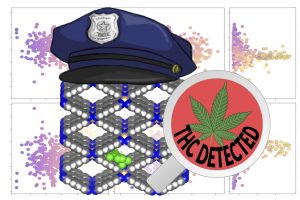D. Ongari, Y. M. Liu, and B. Smit, Can metal–organic frameworks be used for cannabis breathalyzers? ACS Appl. Mater. Interfaces (2019) doi: 10.1021/acsami.9b13357
Abstract
Δ9-tetrahydrocannabinol (THC) is the principal psychoactive component of cannabis, and there is an urgent need to build low-cost and portable devices that can detect its presence from breath. Similarly to alcohol detectors, these tools can be used by law enforcement to determine driver intoxication and enforce safer and more regulated use of cannabis. In this work, we propose to use a class of microporous crystals, metal-organic frameworks (MOFs), to selectively adsorb THC that can be later detected using optical, electrochemical, or fluorescence-based sensing methods. We screened computationally more than 5000 MOFs, highlighting the materials that have the largest affinity with THC, as well as the highest selectivity against water, showing that it is thermodynamically feasible for MOFs to adsorb THC from humid breath. We propose and compare different models for THC and different computational protocols to rank the promising materials, also presenting a novel approach to assess the permeability of nonspherical molecules in a porous framework. We identified three adsorption motifs in MOFs with high affinity to THC, which we refer to as “narrow channels”, “thick walls” and “parking spots”. Therefore, we expect our protocols and our findings to be generalizable for different classes of microporous materials, and also for investigating the adsorption properties of other large molecules that, like THC, have an nonspherical shape.
